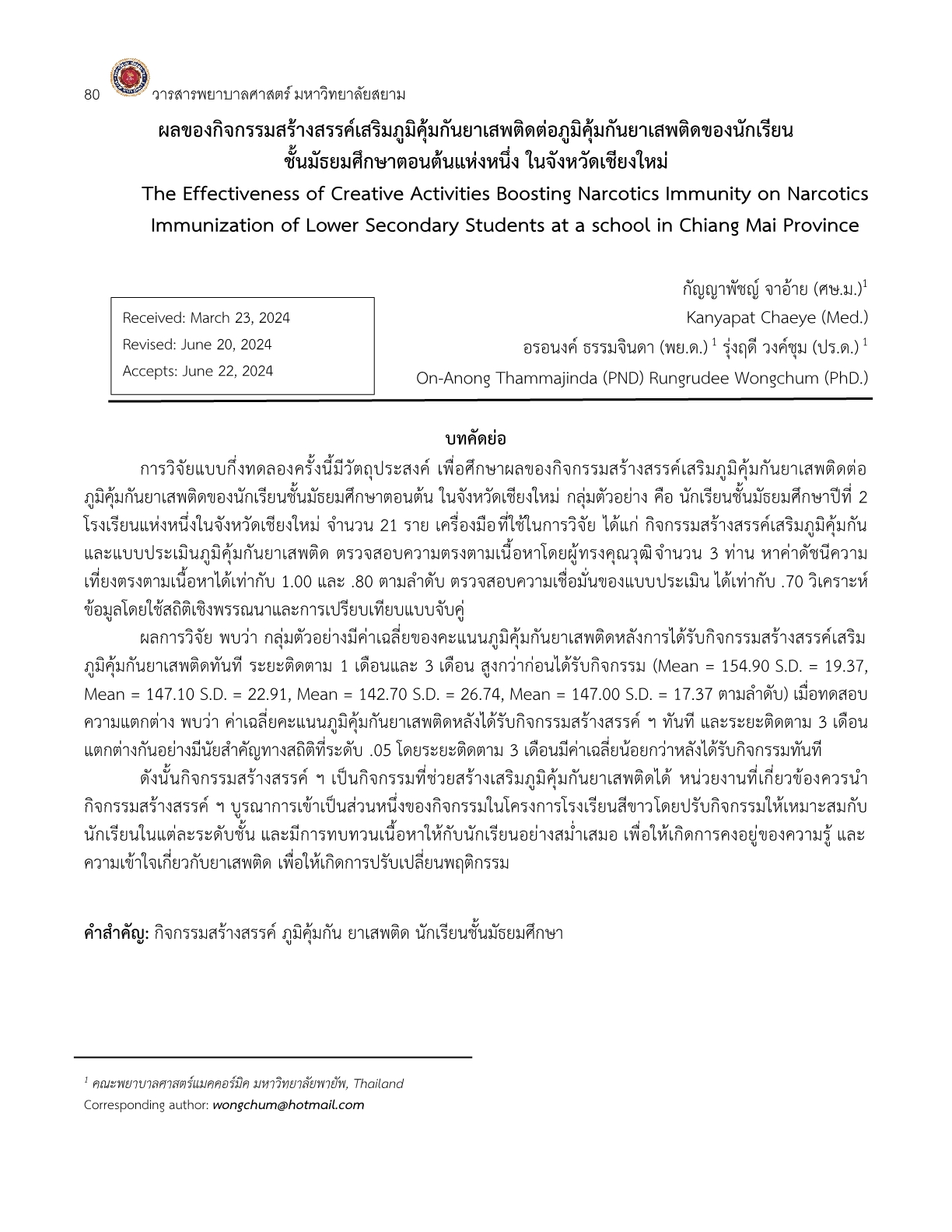The Effectiveness of Creative Activities Boosting Narcotics Immunity on Narcotics Immunization of Lower Secondary Students at a school in Chiang Mai Province
Keywords:
creative activities, immunization, secondary studentsAbstract
The purpose of this quasi-experimental research was to investigate the effectiveness of creative narcotics immune boosting activities on narcotics immunization of lower secondary students in Chiang Mai province. The participants consisted of 21 lower secondary students at a school in Chiang Mai. The research tools consisted of creative activities to enhance narcotics and substance abuse immunization and narcotics and substance abuse immunization assessment form. Research tools were examined for content validity by 3 experts with a CVI of 1.00 and .80 and reliability was .70. Data were analyzed using descriptive statistics and paired t-test.
The results showed that after receiving creative activities, during the follow-up period of 1 month, and 3 months, the mean scores of narcotics and substance abuse levels were higher than before receiving creative activities (Mean=154.90 S.D.=19.37, Mean=147.10 S.D.=22.91, Mean=142.70 S.D.=26.74, Mean=147.00 S.D.=17.37, respectively). After comparing the mean score of immediately after receiving creative activities and the 3-month follow-up period, there was significantly different at the .05 level. It showed that the mean score of the 3-month follow-up period was lower than the mean score of immediately after receiving creative activities.
Therefore, creative activities enhance narcotics and substance abuse immunization. The activities should be integrated into the White School project for drug-free and adapted to suit students at different levels. Also, regular review of content and adjustment of students’ attitudes on drugs to ensure the persistence of knowledge and understanding of narcotics and substance abuse immunization.
References
กรมพินิจและคุ้มครองเด็กและเยาวชน. (2563). รายงานสถิติคดีประจำปี พ.ศ. 2563. http://www.djop.go.th/images/djopimage/year63-2.pdf.
กรมสุขภาพจิต. (2562). สำรวจพฤติกรรมวัยรุ่นไทยหนักสุดติดยา. https://dmh.go.th/news-dmh/view.asp?id=28478.
กุสุมา สว่างพันธุ์. (2558). ภูมิคุ้มกันยาเสพติดและสารเสพติดของนักเรียนชั้นประถมศึกษาตอนปลายในเขตตำบลดอนสมบูรณ์ อำเภอยางตลาด จังหวัดกาฬสินธุ์. วารสารการพัฒนาสุขภาพชุมชน มหาวิทยาลัยขอนแก่น, 3(4), 498-513.
ทิศนา แขมมณี. (2560). ศาสตร์การสอน: องค์ความรู้เพื่อการจัดกระบวนการเรียนรู้ที่มีประสิทธิภาพ (พิมพ์ครั้งที่ 21). กรุงเทพฯ: สำนักพิมพ์แห่งจุฬาลงกรณ์มหาวิทยาลัย.
ธีรวัฒน์ พงศ์ภาณุพัฒน์, และคณะ. (2565). ผลของโปรแกรมการสร้างเสริมทักษะชีวิตเพื่อป้องกันการเสพสารเสพติดของนักเรียนระดับมัธยมศึกษา ตำบลอิสาณ อำเภอเมือง จังหวัดบุรีรัมย์. วารสารการแพทย์ โรงพยาบาลศรีสะเกษ สุรินทร์ บุรีรัมย์, 37(3): 559-568.
นภีพัชร เกษรา. (2562). การถอดบทเรียนความสำเร็จของโครงการ ครูแดร์ (D.A.R.E.) ประเทศไทย สำหรับการแก้ไขปัญหายาเสพติดในเด็กนักเรียน กรณีศึกษา กองร้อยตำรวจตระเวนชายแดนที่ 117 อำเภอเมือง จังหวัดตราด. การค้นคว้าอิสระ หลักสูตรรัฐประศาสนศาสตร์มหาบัณฑิตมหาวิทยาลัยรามคำแหง. www3.ru.ac.th/mpa-abstract/files/2562_ 1582275307_6114830064.pdf.
นาถนภา นกดี. (2563). การศึกษาความสัมพันธ์ของภาระงานทางคลื่นสมองในการทำงานสองอย่างพร้อมกันจาก การจดจำระยะสั้น [วิทยานิพนธ์ปริญญามหาบัณฑิตไม่ได้ตีพิมพ์]. มหาวิทยาลัยศิลปากร.
บุษราภรณ์ ติเยาว์, ปาริชาติ วลัยเสถียร, และวิวัฒน์ หามนตรี. (2562). ขบวนการจิตอาสา : การขัดเกลาทางสังคมกับการพัฒนาตนของเยาวชนใน กรุงเทพมหานครและปริมณฑล. วารสารสันติศึกษาปริทรรศน์ มจร, 7(ฉบับเพิ่มเติม), 67-78.
วรางคณา จันทร์คง, และปาจรีย์ ผลประเสริฐ. (2561). แนวทางการสร้างภูมิคุ้มกันและป้องกันยาเสพติดในกลุ่มเด็กและเยาวชนนอกสถานศึกษา ในจังหวัดกําแพงเพชร. วารสารกฎหมายสุขภาพและสาธารณสุข, 4(1), 65-74.
ศรณรงค์ ปล่องทอง และคณะ. (2565). การประยุกต์ใช้โปรแกรมการเสริมสร้างความตระหนักต่อผลกระทบการใช้กัญชา ของเยาวชนนอกระบบ จังหวัดศรีสะเกษ. รายงานวิจัย. กรุงเทพฯ: ศูนย์ศึกษาปัญหาการเสพติด (ศศก.).
ศุลีวงศ์ สนสุผล, สุรีย์ จันทรโมลี, และประภาเพ็ญ สุวรรณ. (2561). ประสิทธิผลของโปรแกรมการปรับเปลี่ยนพฤติกรรมป้องกันการเสพสารเสพติดในนักเรียนมัธยมศึกษาตอนต้น จังหวัดบุรีรัมย์. รมยสาร, 16(1), 207-224.
สถาบันบําบัดรักษาและฟื้นฟูผู้ติดยาเสพติดแห่งชาติบรมราชชนนี. (2563). จำนวนและร้อยละของผู้ป่วยยาเสพติดทั้งหมด ปีงบประมาณ 2565-2566. http://www.pmnidat.go.th/thai/index.php?option=com_content&task=view&id=4596&Itemid=53.
สุริยัน บุญแท้. (2563). โครงการสำรวจทัศนคติและพฤติกรรมการใช้สารเสพติด: กรณีศึกษาประชาชนอายุ 15 - 65 ปี ใน 20 จังหวัดทั่วทุกภูมิภาคของประเทศ. รายงานวิจัยฉบับสมบูรณ์. สำนักงานกองทุนสนับสนุนการสร้างเสริมสุขภาพ (สสส.).
สุกานดา จันทวารีย์, และสุทธิพันธ์ อรัญญวาส. (2560). กลยุทธ์การเสริมสร้างภูมิคุ้มกันและป้องกันยาเสพติดในสถานศึกษา. วารสารวิชาการธรรมทรรศน์, 17(3), 389-401.
สุทธญาณ์ จําปาทอง, จําเนียร พลหาญ, และอุรสา พรหมทา. (2564). รูปแบบการพัฒนาทักษะชีวิตของนักเรียนระดับชั้นมัธยมศึกษาตอนปลาย. วารสารวิชาการธรรมทรรศน์, 21(4), 129-141.
สุวพันธุ์ คะโยธา, และวุธิพงศ์ ภักดีกุล. (2561). ปัจจัยเสี่ยงต่อการใช้สารเสพติดและปัจจัยที่มีผลต่อการป้องกันยาเสพติดของเยาวชนในโรงเรียนมัธยมศึกษา เขตเทศบาลนครสกลนคร. วารสารโรงพยาบาลสกลนคร, 21(3), 85-95.
สำนักงานคณะกรรมการศึกษาขั้นพื้นฐาน และสำนักงานคณะกรรมการป้องกัน และปราบปรมยาเสพติด. (2558). แนวทางการจัดกิจกรรมพัฒนาทักษะชีวิตเพื่อการสร้างภูมิคุ้มกันปัญหายาเสพติด ระดับมัธยมศึกษาตอนต้น. กรุงเทพฯ: โรงพิมพ์ชุมนุมสหกรณ์การเกษตรแห่งประเทศไทย จำกัด.
สำนักงานคณะกรรมการป้องกันและปราบปรามยาเสพติด. (2566). นโยบายและแผนระดับชาติว่าด้วยการป้องกัน ปราบปราม และแก้ไขปัญหายาเสพติด (พ.ศ. 2566-2570). กรุงเทพฯ: สำนักงานคณะกรรมการป้องกันและปราบปรามยาเสพติด.
Atkinson, R. C., & Shiffrin, R. M. (1968). Human memory: a proposed system and its control processes. In: Spence KW, Spence JT, editors. The psychology of learning and motivation (Volume 2). Academic Press.
Locke, A. E., & Latham, P. G. (1990). A theory of goal setting and task performance. Prentice-Hall.
Prochaska, J. O., & DiClemente, C. C. (1984). The transtheoretical approach: Crossing the traditional boundaries of therapy. Dow-Jones/Irwin.
United Nations Office on Drugs and Crime. (2023). World drug report 2023 [Internet]. United Nations Publication. http://www.unodc.org/res/WDR-2023/WDR23_Exsum_fin_DP.pdf
Yaimai, W., Oopakarn, K., Phumvichitr, C., Anukulkijkul, C., Pornnoparat, N., Yindeepolcharoen, N., Uthong, N., Charoenjai, N., Rachapongthai, N., Theeraphanvikul, R., Ruamma, S., Soontrapornchai., Srimahachota, S., Rattanasumawong, W., Rangsin, R., and Sakboonyarat, B. (2019). Prevalence and associated risk factors of substance abuse among adolescents in rural communities, central Thailand: a cross-sectional study. Journal of Southeast Asian Medical Research, 3(2), 73-81.

Downloads
Published
How to Cite
Issue
Section
License
Copyright (c) 2024 Journal of Nursing, Siam University

This work is licensed under a Creative Commons Attribution-NonCommercial-NoDerivatives 4.0 International License.
Content and information published in the Journal of Nursing, Siam University is the comment and responsibility of the authors.
Articles, information, images, etc. published in the Journal of Nursing. Siam University is the copyright of the Journal of Nursing, Siam University. If any person or entity wants to take all or part of it for publication for any purposes, please reference the Journal of Nursing, Siam University.


